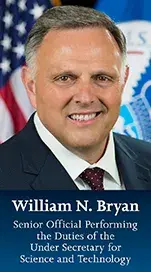When Heinrich Hertz discovered radio waves in 1887, he never dreamt they would revolutionize communication forever. Apparently, he saw little practical value in the phenomenon at the time. However, those who came after did see the incredible potential—making “wireless telegraphy” and many other innovations possible.
 Flash forward to today and the Department of Homeland Security (DHS) Science and Technology Directorate (S&T) is still finding new ways to leverage radio. Today, in honor of World Radio Day, we’re taking a look at how this oh-so-useful-part of our electromagnetic spectrum is serving the mission of securing our homeland.
Flash forward to today and the Department of Homeland Security (DHS) Science and Technology Directorate (S&T) is still finding new ways to leverage radio. Today, in honor of World Radio Day, we’re taking a look at how this oh-so-useful-part of our electromagnetic spectrum is serving the mission of securing our homeland.
Where there is a useful technology, there is usually an adversary ready to exploit or undermine it. Jamming can block radio, cellular, GPS, and other wireless systems that federal law enforcement and first responders depend on. The First Responder Electronic Jamming Exercise series was designed to prepare responders for that eventuality. Conducted in 2016 and again in 2017, this week-long event brought together nearly 100 federal, state, and local public safety and private organizations to test tactics and technologies for identifying, locating, and mitigating illegal jamming of communications systems. A Radio Frequency Interference Best Practices Guidebook will be released later this year. In the meantime, you can view the “Are you a victim of electronic jamming?” infographic on our website.
Radio is regularly depended upon by millions of first responders, but some situations make this type of communication difficult. During a hazardous material incident, personal protective equipment (PPE) may need to be worn. This can make using hand-held, two-way radios nearly impossible. Accessories such as microphones, headsets, and earpieces can solve this problem and are known as In-Suit Communications (ISC) Equipment.
In August 2019, DHS S&T’s National Urban Science and Technology Laboratory (NUSTL) conducted a System Assessment and Validation for Emergency Responders (SAVER) field assessment, supported by the Department of Energy’s Pacific Northwest National Laboratory (PNNL) to evaluate ISC equipment. First responders tested the equipment and helped assess its usability. The resulting SAVER report will be released this Spring by NUSTL and serve as a guide for agencies across the country as they decide how to address the challenge of using radio while wearing PPE.
The many fire protection, law enforcement, emergency medical, and other public safety agencies across the country have various challenges in need of innovative technology solutions. Different equipment may be favored by a certain discipline or region, but that doesn’t necessarily mean it is the best possible tool for the job. The Project 25 Compliance Assessment Program (P25 CAP) strives to establish standards and compliance test protocols for ensuring the interoperability of the digital communications equipment emergency responders use. A major priority of P25 CAP is compatibility between radios and tower equipment.
P25 CAP is a partnership between DHS S&T, the emergency response community, private industry, and SAFECOM – an organization managed by DHS Cybersecurity and Infrastructure Security Agency and dedicated to effective public safety communications. DHS offers multiple avenues to procure funding for the purchase of complying communications equipment, including Federal Emergency Management Agency grants.
The Radio Internet-Protocol Communications Module (RIC-M) is a P25-compatible, after-market technology solution that allows agencies to easily upgrade and reconfigure legacy systems at a low cost. RIC-M allows many older base station systems to be used for another 10 to 20 years. DHS S&T owns the intellectual property rights to this useful gadget and all RIC-M royalties are used to fund the development of new technologies for first responders.
Some systems will eventually become obsolete, but scientists are not done finding new ways to solve problems using radio. The Silicon Valley Innovation Program’s “Security for the Internet of Things” solicitation has yielded an exciting security solution that will enable system administrators to gain real-time situational awareness of threats on connected devices. The award, announced in October 2019, will support the development of sensors that collect radio frequency emission data from devices and analyze it for cyber threats. The resulting technology is expected to become commercially available later this year.
That’s not the only crowd sourcing radio success, though. The $1.55 million Opioid Detection Challenge, a global prize competition for rapid, nonintrusive detection tools that will help find illicit opioids in international mail, also dialed in to radio technology. The runner up winner, selected by DHS S&T, White House Office of National Drug Control Policy, U.S. Customs and Border Protection, and the U.S. Postal Inspection Service, uses radio-frequency signals to search for specific materials. An alarm is triggered when a signal associated with an illicit substance is detected.
These are just a few examples of ways radio relates to the work of DHS S&T. Imagine what mankind will do with another century of innovation! And visit our website to learn more about the research and development efforts of DHS S&T. Over and out!
